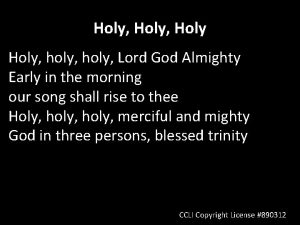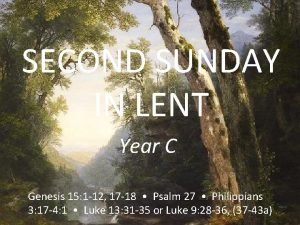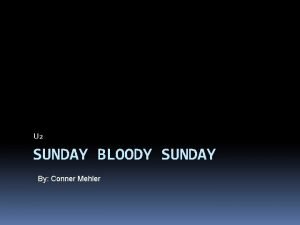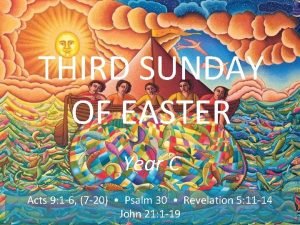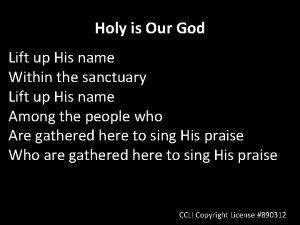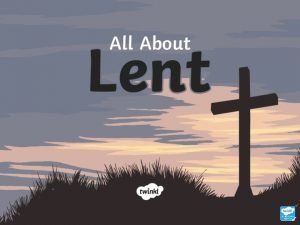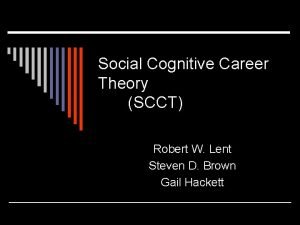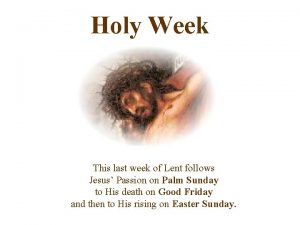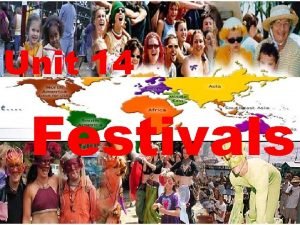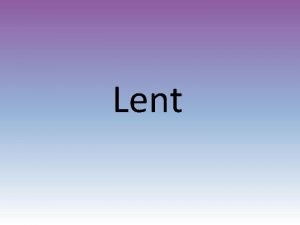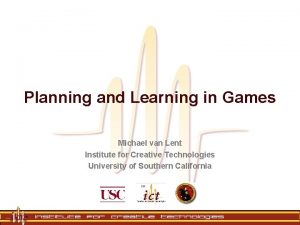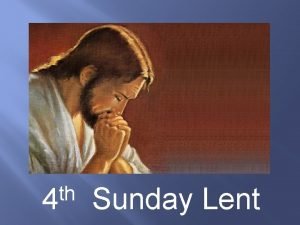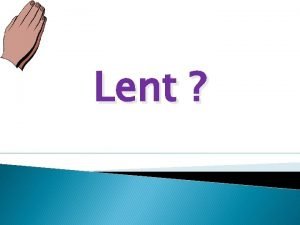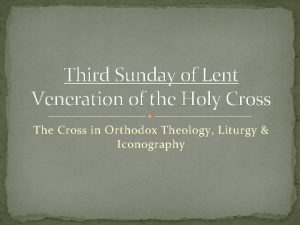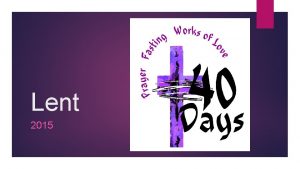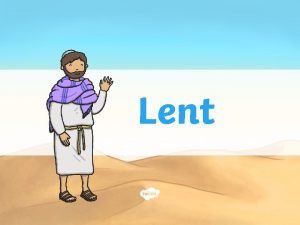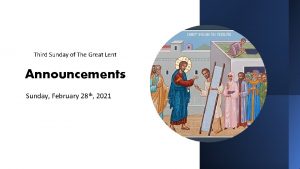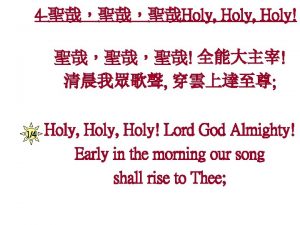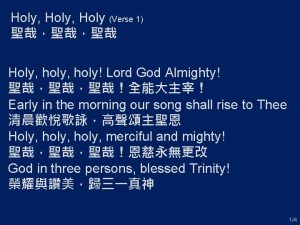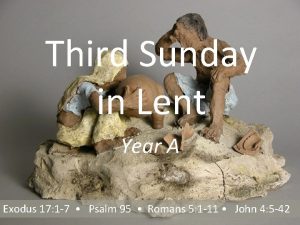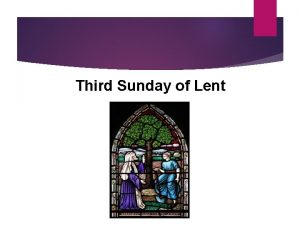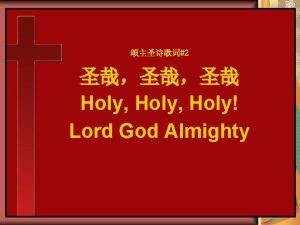Third Sunday of Lent Veneration of the Holy






























































- Slides: 62

Third Sunday of Lent Veneration of the Holy Cross The Cross in Orthodox Theology, Liturgy & Iconography


Earliest Representation of Cross �How and when did Christians start to depict images of Jesus on the cross? Some believe the early church avoided images of Jesus on the cross until the fourth or fifth century. In “The Staurogram: Earliest Depiction of Jesus’ Crucifixion” the March/April 2013 issue of Biblical Archaeology Review, Larry Hurtado highlights an early Christian crucifixion symbol that sets the date back by 150– 200 years. Hurtado describes how a symbol known as a staurogram is created out of the Greek letters tau-rho:

Earliest Representation of Cross The staurogram combines the Greek letters tau-rho to stand in for parts of the Greek words for “cross” (stauros) and “crucify” (stauroō) in Bodmer papyrus P 75. Staurograms serve as the earliest images of Jesus on the cross, predating other Christian crucifixion imagery by 200 years. Foundation Martin Bodmer.

Earliest Representation of Cross �The earliest Christian uses of this tau-rho combination make up what is known as a staurogram. �The tau-rho staurogram is one of several christograms, or monogram-like devices used by ancient Christians, to refer to Jesus. The staurogram is visual—the tau-rho combinations create images of Jesus on the cross, making the staurogram the earliest Christian images of Jesus on the cross. (www. biblicalarchaeology. org/daily/biblicaltopics/crucifixion/the-staurogram/)


Graffito from around the year 200, clearly mocking Christian belief in a crucified Savior.


Constantine and the Sign of the Cross


Constantine and the Cross Did Constantine simply change his favourite pagan sun god ‘Sol Invictus’ to Jesus? The Sol Invictus, the “Unconquered Sun” was the official sun god of the Roman empire and a patron of the soldiers from 274 AD.

Imperial Coin – Christ on one face, Constantine & Helen on reverse face: Pantokrator and Imperatrix. The marriage of church and state begins here. Cross is the central symbol.


The Cross in Iconography �Before the time of the emperor Constantine in the 4 th century, Christians were extremely reticent about portraying the cross because it might expose them to ridicule or danger. After Constantine converted to Christianity, he abolished crucifixion as a death penalty and promoted, as symbols of the Christian faith, both the cross and the chi-rho monogram of the name of Christ. The symbols became immensely popular in Christian art and funerary monuments from c. 350.

Chi-Rho with a wreath symbolizing victory of the Resurrection (c. 350) Roman soldiers who 300 years earlier arrested and paraded Jesus to his death now kneel under the banner of the resurrected Christ. Victory of Christian faith over Rome’s pagan past? Or accommodation?

The “Passion Sarcophagus” (mid-4 th century, Vatican) Note how the crucifixion scene is absent and is replaced by the Chi-Rho http: //phdiva. blogspot. com/2011/08/early-images-ofcrucifixion. html

Ivory plaque (c. AD 420, British Museum). It's the earliest depiction of the crucifixion which depicts Jesus for certain, as indicated by the inscription: REX IUD[AEORUM]

Early depiction of the crucifixion. Jesus and the thieves are shown in the orans pose. (Santa Sabina in Rome, 422 -433).

The Cross in Iconography �For several centuries after Constantine, Christian devotion to the cross centred on the victory of Christ over the powers of evil and death, and realistic portrayal of his suffering was avoided. The earliest crucifixes (crosses containing a representation of Christ) depict Christ alive, with eyes open and arms extended, his Godhead manifest, even though he is pierced and dead in his manhood. By the 9 th century, however, artists began to stress the realistic aspects of Christ’s suffering and death.


Hymnography of the 3 rd Sunday �Shine, Cross of the Lord, shine with the light of your grace upon the hearts of those that honor you. With love inspired by God we embrace you, O desire of the world. Through you our tears of sorrow are wiped away; we are delivered from the snares of death and have passed over to unending joy. Show us the glory of your beauty… �Hail, life-giving Cross, unconquerable trophy of the true faith, door to Paradise, comfort of the faithful, rampart set about the Church. Through you the curse is utterly destroyed, the power of death is swallowed up, and we are raised from earth to heaven…

Hymnography of the 3 rd Sunday �Hail, life-giving Cross, the fair Paradise of the Church, Tree of incorruption that brings us the enjoyment of eternal glory. Through you demons are driven back and the angelic hosts rejoice with one accord as the faithful enjoy the feast. You are an invincible weapon, an unbroken stronghold. You are the victory of kings and the glory of priests. Grant us now to draw near to the Passion of Christ and to his Resurrection.

Hymnography of the 3 rd Sunday �Come, all you kindred of the nations (αἱ πατριαὶ τῶν ἐθνῶν), and let us honor the Cross of the Lord. Rejoice, O Cross, perfect redemption of fallen Adam. Glorying in you, our faithful kings laid low by your might the people of Ishmael. We Christians kiss you now with awe… �Apolytikion (literal translation) O Lord, save your people and bless your inheritance. Grant victory to the kings over barbarians and by your Cross guard your commonwealth.

Hymnography of the 3 rd Sunday � Come Adam and Eve, our first father and mother, who fell from the choir on high through the envy of the murderer of man, when with bitter pleasure you tasted from the tree in Paradise. See, the Tree of the Cross, revered by all, draws near. Run with haste and embrace it joyfully. O precious Cross, partaking of your fruit, we have gained incorruption; we are restored once more to Eden. � In Paradise of old the tree stripped me bare; for by giving me its fruit to eat, the enemy brought in death. But now the Tree of the Cross that clothes humans with the garment of life has been set up on earth, and the whole world is filled with boundless joy. As we venerate, let us with one voice cry out to God: Your house is full of glory!

Mid 12 th century Palatine Chapel, Palermo, Sicily

Hymnography of the 3 rd Sunday � O Christ God, of your own will you accepted crucifixion, so that all humankind might be restored to life. Out of love for humankind, you took the pen of the Cross in your bloody fingers and in the red ink of royalty you signed our absolution. We are in danger once again of being separated from you; forsake us not! Take pity on your people in distress… Rise up and fight against our enemies in your almighty power! � When it beheld you, the Fashioner and Creator of all, hanging naked on the Cross, the whole creation was transfixed by fear, and it lamented… and the angelic powers cried in amazement: “O strange wonder! The Judge is judged, and suffers willingly, for the salvation and renewal of the world. ”

Hymnography of the 3 rd Sunday � Kontakion The fiery sword no longer guards the gate of Eden, for in a strange and glorious way the wood of the Cross has quenched its flames. The sting of death and the victory of hell are now destroyed, for You have come, my Savior, proclaiming to those in the realm of Death: “Return again to Paradise!” � Oikos Pilate set up three crosses in the place of the Skull, two for the thieves and one for the Giver of Life. Seeing Him, Death (ᾍδης, not Hell) cries out: “O my ministers and powers! Who is that has fixed a nail in my heart? A wooden spear has pierced me suddenly, and I am torn apart… I am forced to cast out Adam and Eve and their posterity. A tree brought them to my realm, but now the Tree of the Cross brings them back again to Paradise. ”

Apse of San Clemente in Rome, with Mosaic of the Cross as Tree of Life

Apse of San Clemente in Rome, with Mosaic of the Cross as Tree of Life

Typology When now we venerate the Cross, which Moses once prefigured (ἐτύπου) with his outstretched arms, we put to flight the invisible Amalek and so gain salvation. Moses saw your mystery prefigured (τυπικῶς) in the bush, O hallowed Virgin. Just as the flames did not consume it, so the fire of the Godhead did not consume your womb.

Typology Garden of Gethsemane Eden and Gethsemane: Two gardens, two choices �The Church has been revealed as a second Paradise, having within it, like the first Paradise of old, a tree of life, your Cross, O Lord. By touching it we share in immortality.

Typology �The Lord who delivered the three youths from the flames took flesh and came upon the earth. Nailed to the Cross, he has granted us salvation. He is the God of our fathers, who alone is blessed and greatly glorified.

Typology Daniel, great among Daniel in prophets, was cast Catacombs into the lions’ den; of Rome, late 2 nd to but stretching out early 3 rd his hands in the form of the Cross, he century was delivered from their mouths and was kept unharmed, blessing Christ our God for ever.

Monastery of the Holy Cross, Jerusalem - A Greek-Orthodox monastery, according to tradition, the site of the tree that was used to build the cross of the crucifixion. The Holy tree, according to the tradition and the local paintings in the Monastery, was based on a triplet seeding (pine + cypress + cedar) that Abraham gave to Lot planted the tree at this site and watered it with waters he fetched from the Jordan river. The tree was later used to create the Holy Cross on which Jesus was crucified. A room inside the Monastery marks the site of the tree. The cross was later buried in the grave of Jesus (Holy Sepulchre). Fragments of the cross were found by Helen, the mother of Emperor Constantine who discovered the vault in her visit (326 AD). They were transferred to Rome and are on display in "Santa Croce in Gerusalemme" (Church of the Holy Cross)

Reverse Typology �Today the Master of creation and the Lord of glory is nailed to the Cross and his side is pierced; he who is the sweetness of the Church tastes gall and vinegar. A crown of thorns is put upon him who covers the heaven with clouds. He is clothed in a cloak of mockery, and he who formed man with his hands is struck by a hand of clay. He who wraps the heaven in clouds is smitten upon his back. He accepts spitting and scourging, reproach and buffeting. And all these things my deliverer endures for me who am condemned, that in his compassion he may save the world from error (ἐκ πλάνης).

Hymnography of the 3 rd Sunday �O Christ God, of your own will you accepted crucifixion, so that all humankind might be restored to life. Out of love for humankind, you took the pen of the Cross in your bloody fingers and in the red ink of royalty you signed our absolution. �Colossians 2: 13 -15 And you, who were dead in trespasses…, God made alive together with him, having forgiven us all our trespasses, erasing the record (χειρόγραφον) that stood against us with its legal demands. He set this aside, nailing it to the cross. He disarmed the rulers and authorities and made a public example of them, triumphing over them in it.

Reconciliation �Colossians 1: 19 -20 For in him all the fullness of God was pleased to dwell, and through him to reconcile to himself all things, whether on earth or in heaven, making peace by the blood of his cross. �St. Irenaeus of Lyons (2 nd century) The Lord redeemed us by his blood and gave his life for our life, his flesh for our flesh, and poured out the Spirit of the Father to unite us and reconcile God and man, bringing God down to man through the Spirit, and raising man to God through his incarnation, and by his coming truly and surely conferring on us immortality by means of our fellowship with God.

Orthodox Theology of the Cross Anaphora of St. Basil: Becoming incarnate from a holy virgin, he emptied himself, taking the form of a servant, conforming to the body of our lowliness, that he might change us into the likeness of the image of his glory. For, since through man sin came into the world, and through sin death, it pleased your only-begotten Son, who is in your bosom, O God and Father, to be born of a woman, the holy Theotokos. Born under the law, he condemned sin in his flesh, so that those who died in Adam may be brought to life in him, your Christ.

The Divine Kenosis Philippians 2: 5 -11 Have this mind among yourselves, which is yours in Christ Jesus, who, though he was in the form of God, did not count equality with God a thing to be grasped, but emptied himself, taking the form of a servant, being born in the likeness of men. And being found in human form he humbled himself and became obedient unto death, even death on a cross. Therefore God has highly exalted him and bestowed on him the name which is above every name, that at the name of Jesus every knee should bow, in heaven and on earth and under the earth, and every tongue confess that Jesus Christ is Lord, to the glory of God the Father.

The Divine Kenosis �Kenosis of divinity almost to point of extinction - darkness of non-being and forsakenness by God! �“Eli, lama sabachthani? ” In the name of creation, the God-Man cries out to God that he has forsaken him. �The bottomless depth of kenosis is equaled only by the depths of God’s love. �Divinity cannot die; but it co-dies with Christ’s dying humanity. This is the mystery of the hypostatic union.

The Divine Kenosis �Docetism is denial of Christ’s incarnation and work. �The God-Man suffered and tasted death not only in his humanity but in his Divine-Humanity �This is perhaps the most valid reason for the seemingly excessive use in Orthodox hymnography of “Christ our God” instead of “Christ the Lord” or other such phrases - danger of over-emphasizing the divinity, but that’s how serious the Church took the danger of Docetism and other heresies that threatened the divine participation in redemption!

Orthodox Theology of the Cross Anaphora of St. Basil: Having cleansed us by water and sanctified us with the Holy Spirit, he gave himself as ransom to death in which we were held captive, sold under sin. Descending into the realm of Death through the Cross, that he might fill all things with himself, he loosed the bonds of death. He rose on the third day, having opened a path for all flesh to the resurrection from the dead, since it was not possible that the Author of life would be dominated by decay. So he became the first-fruits of those who have fallen asleep, the first-born of the dead, that he might be himself the first in all things.





Holistic Theology of the Cross It is often claimed that the Orthodox Church downplays the significance of the Cross because it emphasizes the Incarnation, Resurrection, Transfiguration - and deification as the essence of salvation. There is some truth to this criticism - IF we take Western theology as the standard by which to measure Orthodox theology. But Orthodox theology takes a more holistic approach to the subject of redemption, and so the Cross of Jesus Christ is not seen in isolation as the only event that brought salvation. The cosmic approach of Orthodoxy also avoids the narrow views of some Western theologies.

Holistic Theology of the Cross Clear teaching in NT that Christ offered the redemptive sacrifice of his blood to take upon himself our sins: � Ephesians 1: 7 In him we have redemption (ἀπολύτρωσιν) through his blood, the forgiveness of our trespasses, according to the riches of his grace. � Romans 5: 8 -10 But God proves his love for us in that while we still were sinners Christ died for us. Much more surely then, now that we have been justified by his blood, will we be saved through him from the wrath of God. For if while we were enemies, we were reconciled to God through the death of his Son, much more surely, having been reconciled, will we be saved by his life.

Holistic Theology of the Cross �St. Irenaeus of Lyons: He who was powerful Word and also truly man redeemed us by his own blood and gave himself as a ransom for those who had been taken into captivity… attaining his purpose not by force… but by way of persuasion. �The Lord restored us to friendship through his incarnation, becoming the ‘mediator between God and man. ’ On our behalf he propitiated the Father, against whom we had sinned, and canceled our disobedience by his obedience, restoring us to fellowship with our Maker and submission to him.

Holistic Theology of the Cross �St. Irenaeus of Lyons is one of the leading representatives of what has been called the ‘Eastern’ or ‘incarnationalist” doctrine of redemption. Gustav Aulén, in his extremely important and influential book, Christus Victor, sees in Irenaeus the ‘classical’ theory of the Atonement, doing justice to every aspect of the work of Christ regarded as an act of God, and free from the forensic notions of the later ‘Western’ view. (Henry Bettenson, The Early Christian Fathers)

Holistic Theology of the Cross �When the Son of God took flesh, he became like us in everything except sin (Heb. 4: 15). In assuming human nature, he deified it. Since human nature is one, this gave us the potential of receiving grace and adoption. But because of sin, we could not actualize this potential. So Christ, having overcome the barrier of nature at his incarnation, now had to break down the barrier of sin. He would do this through his death. �St. Nicholas Cabasilas: Christ broke down the three barriers that separated man from God: the barrier of nature by his Incarnation, the barrier of sin by his Death, and the barrier of death by his Resurrection.

Holistic Theology of the Cross At his death, Christ broke down the barrier of sin. But there was one barrier left: death itself. This Christ broke down at his Resurrection. As in Adam all die, writes St. Paul, so in Christ shall be made alive. But every man according to his order: Christ the firstfruits; afterward they that are Christ’s at his coming (I Cor. 15: 22 -23). Through Christ’s Resurrection, all humankind is made capable of resurrection. This is because human nature is one. St. Paul affirms: For since by man came death, by man came also the resurrection of the dead (I Cor. 15: 21).

Love: the meaning of the Cross �“The Cross is God Himself in His revelation to the world. The Cross is the sacrificial essence of love, since love is sacrifice, self-surrender, self-abnegation, voluntary self-renunciation for the sake of the beloved. The Cross is the exchange of love, indeed love itself is exchange. �“The Holy Trinity is the eternal Cross as the sacrificial exchange of Three, the single life born of voluntary surrender, of a threefold self-surrender, of being dissolved in the divine ocean of sacrificial love. . Love itself, God, in the eternal Cross surrenders Himself for the sake of His love. ” Fr. Sergei Nikolaevich Bulgakov

Love: the meaning of the Cross �St. Isaac the Syrian: “God surrendered His own Son to death on the Cross for the fervent love of creation. For God so loved the world that He gave His only begotten Son to death for our sake (John 3: 16). This was not, however, because He could not have redeemed us in another way, but so that His surpassing love, manifested hereby, might be a teacher unto us. And by the death of His only begotten Son He made us near to Himself. Yea, if He had anything more precious, He would have given it to us, so that by it our race might be His own. ”

“Payment” of “Ransom”? �Mark 10: 45 (also, Matthew 20: 28) For the Son of Man came… to give his life a ransom for many (λύτρον ἀντὶ πολλῶν). ” � 1 Timothy 1: 5 -6 For there is… one mediator between God and humankind, Christ Jesus, himself human, who gave himself a ransom (ἀντίλυτρον) for all. � 1 Peter 1: 18 -19 You know that you were ransomed (ἐλυτρώθητε) from the futile ways inherited from your ancestors… with the precious blood of Christ, like that of a lamb without defect or blemish.

“Payment” of “Ransom”? �Origen, St. Gregory of Nyssa and others said the ransom was paid to the Devil. But St. Gregory of Nazianzus in his 45 th Oration: �To whom was offered the blood that was shed for us, and why was it offered, this precious and glorious blood of our God, our high-priest, our sacrifice? We were held captive by the Evil One, for we had been “sold into the bondage of sin” (Romans 7: 14). Now a ransom is normally paid to the captor, and so the question is: To whom was the ransom offered, and why? To the Evil One? What an outrage! If it is supposed not merely that the thief received a ransom from God, but that the ransom is God himself!

“Payment” of “Ransom”? �If it was paid to the Father, I ask first, why? We were not held captive by him. Secondly, what reason can be given why the blood of the Only-begotten should be pleasing to the Father? For he did not accept even Isaac when he was offered by his father, but he gave a substitute for the sacrifice, a lamb to take his place. �Is it not clear that the Father accepts the sacrifice, not because he demanded or needed it, but because this was part of the divine plan (οικονομία), since man had to be sanctified by the humanity of God; so that he might rescue us by overcoming the tyrant by force…

“Payment” of “Ransom”? �“Where is your sting, O death? Where is your victory, O grave? ” (1 Cor 15: 55) You have been laid low by the cross, put to death by the lifegiver. You are dead, motionless, inert… Let the rest of the mystery be venerated silently” (Oration 45). � 1 Corinthians 15: 24 -28 Then comes the end, when he hands over the kingdom to God the Father, after he has destroyed every ruler and every authority and power… The last enemy to be destroyed is death… When all things are subjected to him, then the Son himself will also be subjected to the one who put all things in subjection under him, so that God may be all in all.

rd Hymnography of the 3 Sunday �Oikos Pilate set up three crosses in the place of the Skull, two for the thieves and one for the Giver of Life. Seeing Him, Death (ᾍδης, not Hell) cries out: “O my ministers and powers! Who is that has fixed a nail in my heart? A wooden spear has pierced me suddenly, and I am torn apart… I am forced to cast out Adam and Eve and their posterity. A tree brought them to my realm, but now the Tree of the Cross brings them back again to Paradise. ”

The Broken Gates of Hades in form of a Cross – Hades personified, bound


The Easter Laugh �From the days of Gregory of Nyssa until today in some Christian circles, the time after Easter has been time for jokes. The priest descends from the altar into the congregation and plays stand-up comic. It is not just comic relief to loosen up after the sadness of Good Friday; the jokes are told to commemorate the divine joke, played on the devil, of the resurrection of Jesus. This view of Christ's atonement as a victory over dark powers dominated the patristic period. �Colossians 2: 15 He disarmed the rulers and authorities and made a public example of them, triumphing over them in it [the Cross].
 Holy holy holy lord god almighty
Holy holy holy lord god almighty Holy are you lord holy is your name
Holy are you lord holy is your name 2nd sunday of lent year c
2nd sunday of lent year c Armando malay
Armando malay Sunday bloody sunday guitar lesson
Sunday bloody sunday guitar lesson Trinity activities for sunday school
Trinity activities for sunday school Trinity sunday 2021 images
Trinity sunday 2021 images Third sunday of easter year c
Third sunday of easter year c Lift up his name
Lift up his name Holyhol
Holyhol What exactly is the holy spirit
What exactly is the holy spirit Deuteronomy genocide
Deuteronomy genocide Be holy as i am holy
Be holy as i am holy Class 6 cavity
Class 6 cavity Gj mount classification
Gj mount classification When does lent finish
When does lent finish Robert w. lent
Robert w. lent Last week of lent
Last week of lent Ramadan and lent similarities
Ramadan and lent similarities Facts on lent
Facts on lent Michael van lent
Michael van lent Sheryl forgot her purse so i lent her ten dollars
Sheryl forgot her purse so i lent her ten dollars Sucre lent def
Sucre lent def Vol lent
Vol lent Fent-lent találkozó vers
Fent-lent találkozó vers Lent calendar 2019
Lent calendar 2019 Lent a williamson iris
Lent a williamson iris Fiona told the truth to julian change into passive voice
Fiona told the truth to julian change into passive voice Bidding prayers
Bidding prayers Fent lent találkozó vers készítése
Fent lent találkozó vers készítése Colleen van lent
Colleen van lent Michael van lent
Michael van lent Lent facts
Lent facts Youtube.com
Youtube.com Vẽ hình chiếu vuông góc của vật thể sau
Vẽ hình chiếu vuông góc của vật thể sau Công của trọng lực
Công của trọng lực 101012 bằng
101012 bằng Thiếu nhi thế giới liên hoan
Thiếu nhi thế giới liên hoan Tỉ lệ cơ thể trẻ em
Tỉ lệ cơ thể trẻ em điện thế nghỉ
điện thế nghỉ Vẽ hình chiếu đứng bằng cạnh của vật thể
Vẽ hình chiếu đứng bằng cạnh của vật thể Quá trình desamine hóa có thể tạo ra
Quá trình desamine hóa có thể tạo ra Môn thể thao bắt đầu bằng chữ f
Môn thể thao bắt đầu bằng chữ f Sơ đồ cơ thể người
Sơ đồ cơ thể người Hát kết hợp bộ gõ cơ thể
Hát kết hợp bộ gõ cơ thể Các số nguyên tố
Các số nguyên tố Thế nào là sự mỏi cơ
Thế nào là sự mỏi cơ độ dài liên kết
độ dài liên kết ưu thế lai là gì
ưu thế lai là gì Gấu đi như thế nào
Gấu đi như thế nào Tư thế ngồi viết
Tư thế ngồi viết Phối cảnh
Phối cảnh Một số thể thơ truyền thống
Một số thể thơ truyền thống Thế nào là hệ số cao nhất
Thế nào là hệ số cao nhất Trời xanh đây là của chúng ta thể thơ
Trời xanh đây là của chúng ta thể thơ Từ ngữ thể hiện lòng nhân hậu
Từ ngữ thể hiện lòng nhân hậu Lp html
Lp html Tư thế ngồi viết
Tư thế ngồi viết Thẻ vin
Thẻ vin đặc điểm cơ thể của người tối cổ
đặc điểm cơ thể của người tối cổ Các châu lục và đại dương trên thế giới
Các châu lục và đại dương trên thế giới Khi nào hổ mẹ dạy hổ con săn mồi
Khi nào hổ mẹ dạy hổ con săn mồi Tư thế worm breton là gì
Tư thế worm breton là gì
